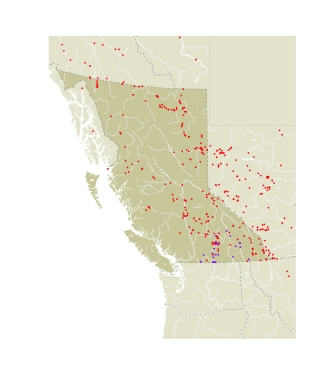View Desktop Page
Papilio canadensis Linnaeus, 1758
Canadian Swallowtail; Swallowtails
Family: Papilionidae (Swallowtails and Apollos)
The Families of Lepidoptera of BC
Canadian Swallowtail; Swallowtails
Family: Papilionidae (Swallowtails and Apollos)
Species account authors: Crispin Guppy and Jon Shepard.
Extracted from Butterflies of British Columbia.
Introduction to the Butterflies of BCExtracted from Butterflies of British Columbia.
The Families of Lepidoptera of BC
Map click to expand contents

Distribution of Papilio canadensis in British Columbia.
(Click on the map to view a larger version.)
Source: Butterflies of British Columbia by Crispin Guppy and Jon Shepard © Royal BC Museum
Species Information click to expand contents
AdultCanadian Tiger Swallowtails are yellow with black bands running from front to back across the wings. The spots in the black margins on the dorsal hindwings are mostly yellow, but the first spot is always orange (in contrast to the Western Tiger Swallowtail), except that sometimes it is missing entirely. These marginal spots are all partly or entirely orange on the underside of the hindwing. The blue markings on the underside of the hindwings are much more developed in the Canadian Tiger Swallowtail than in the Western Tiger Swallowtail. There is a zone of hybridization with the Western Tiger Swallowtail where their ranges overlap.
For many years the Canadian Tiger Swallowtail was considered to be a subspecies of the Eastern Tiger Swallowtail. Recently Hagen and Scriber (1991) and Hagen et al. (1992) demonstrated that they are separate species that fly together in southern Ontario. Eastern Tiger Swallowtails are bivoltine and can mature more successfully on different larval foodplants than Canadian Tiger Swallowtails (with some overlap). Many pupae of hybrids die rather than produce adults.
Immature StagesThe eggs are green, approximately hemispherical, and smooth. Mature larvae are velvet green with eyespots on their middle thoracic segment and a yellow and black stripe between that segment and the next. The eyespot on each side of the thorax of a mature larva is yellow, outlined in black and bisected by a black line. A black line encloses a blue centre spot, and the black transverse band is narrower than the anterior yellow band and does not extend to the spiracular line (Sugden and Ross 1963). The osmeteria are orange (CSG) and the prepupal larvae turn dark reddish brown (Saunders 1869c). Pupae are light brown with a darker brown lateral stripe, two short horns on the head, and a peak at the top of the thorax.
SubspeciesCanadian Tiger Swallowtails were originally described from Newfoundland. There are no recognized subspecies. Papilio rutulus arcticus Skinner was published in December 1906 and is a synonym of P. canadensis, which was published in August 1906 (Martin Honey, pers. comm.).
Genus Description click to expand contents
|
Biology click to expand contents
|
Habitat click to expand contents
|
Distribution click to expand contents
|
Status Information click to expand contents
|
BC Ministry of Environment: BC Species and Ecosystems Explorer--the authoritative source for conservation information in British Columbia. |